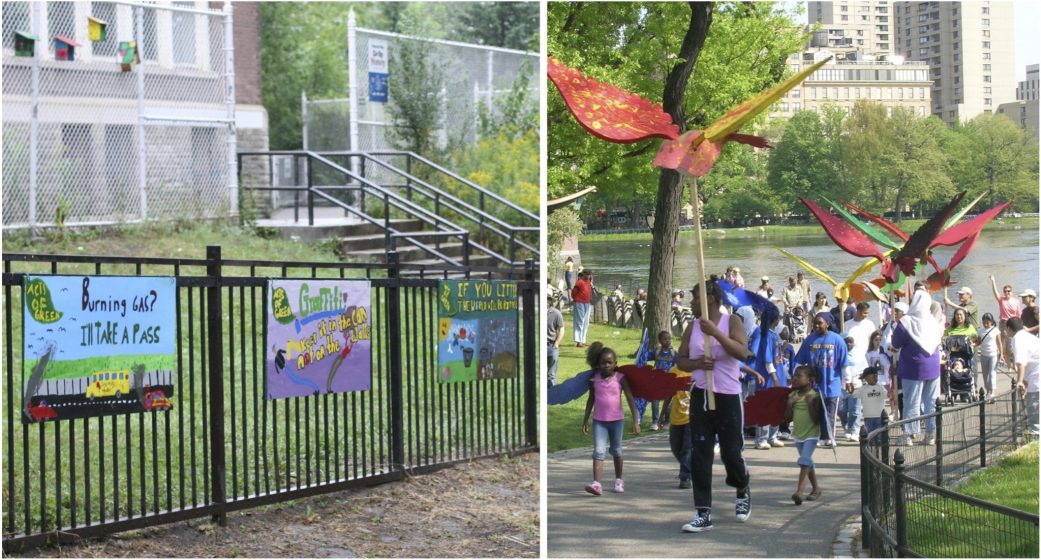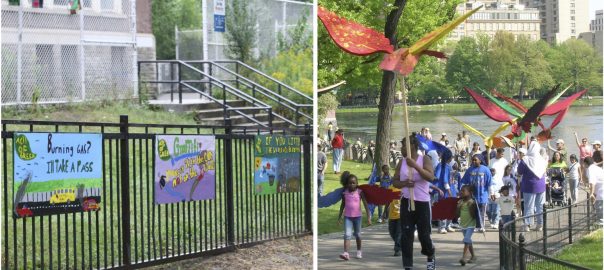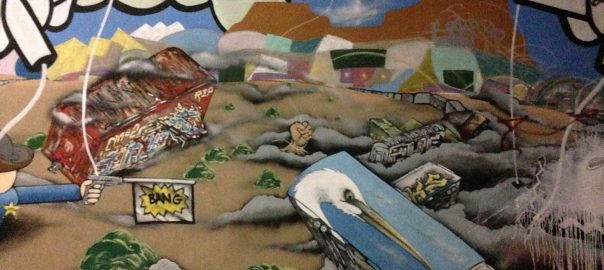Cities around the world are using the arts to enhance urban aesthetic experiences and motivate innovative environmental activism. Manifesting as flash mobs, immersive street theatre, bike parades, pop-up installations, zero-carbon concerts, and participatory storytelling, artists are using their creativity and ingenuity to draw attention to and propose solutions for the environmental challenges of the 21st century city. Environmental arts catalyze environmental learning and action in cities worldwide.
Imagining a more sustainable world through the arts
To see more chapters from the book, click here.
As one of the founders of the 350.org campaign, McKibben draws on the power of the arts to catalyze action on climate change in cities around the world. Using media as diverse as comics, music videos, documentary photography, spoken word poetry, reverse graffiti, performance, puppetry, and aerial art, 350.org is harnessing the energy of artists in unique ways. In Istanbul, activists created a giant inflatable sculpture of lungs, inspired by the art of Artur von Balen, to highlight the effects of CO2 emissions on human health. Working with artists in Lima, Peru, activists designed “Casa Activa,” an arts and activism center that exemplifies what a sustainable future could look like. These and other projects are demonstrating that cities can be used for artistic activism in multiple ways, as inspiration, as material, and as exhibition site.
By cultivating imagination, engagement, connection, and reflection, artists help us to think critically and creatively about ecological degradation, resource extraction, climate change, and other environmental issues. They explore, analyze, and critique the complex materiality and social contexts of urban centers, often leading to innovative sustainability solutions. They demonstrate that the arts make for powerful and personal learning experiences that transcend age and life-stage, inviting citizens to engage with their cities through emotional and creative lenses, and helping to shift attitudinal change into action about and for sustainability.
Greene (1995) referred to this power as “social imagination,” that is, the capacity “to invent visions of what should be and what might be in our deficit society, on the streets where we live, [and] in our schools” (p. 5). Eisner (2002) recognized the similarity between the arts and sciences: “this is what the scientists and artists do; they perceive what is, but imagine what might be, and then use their knowledge, their technical skills, and their sensibilities to pursue what they have imagined” (p. 199). For many then, the arts are a form of research in their own right; they “provide a special way of coming to understand something and how it represents what we know about the world” (Sullivan, 2004, p. 61).
For urban dwellers, opportunities abound for becoming involved in arts-based creation, research, and activism. For example, student teachers at the University of Toronto regularly engage with its public eco-art collection; inspired by what they experience, many join the eco-art club looking to contribute to the next installation. For some, this is the start of engagement with the creative process or their own form of artistic activism; for others, it provides insights about how to do an environmental art project with their own students.
Engaging with environmental education through art-making
Visual artists have been creatively addressing environmental issues in cities for decades, inspiring teaching and learning across multiple educational settings. Alan Sonfist recreated the history of nature in urban spaces (“Time Landscape,” 1978); Agnes Denes planted a brownfield with wheat to raise questions about food security (“Wheatfield: A Confrontation,” 1982); and Joseph Beuys invited citizens to collaboratively combat urban deforestation (“7000 Oaks Project,” 1982). Environmental arts cultivate imagination and provoke reflection, helping citizens to think critically and creatively about environmental issues.
These environmental art pioneers led the way for a new generation of artists, photographers, filmmakers, and architects to combine traditional and digital media to maximize the reach and power of their work. The “Beehive Design Collective” uses techniques drawn from popular education, storytelling, and advertising to collaboratively design large-scale, narrative drawings that illustrate and mobilize support for citizens’ social and eco-justice struggles. “No. 9,” a community-based nonprofit that installs eco-art in urban parks and rivers to encourage citizens to explore their city and environmental issues simultaneously; artist Ian Baxter’s ECOARTVAN was one such project that took learning to city streets. Additionally, artists and scientists of the “Cape Farewell” project bring their explorations of the Arctic, manifested in photography, sculptural installations, and light projections, to urban settings to draw attention to the effects of climate change. Finally, Maya Lin’s “What is Missing” uses permanent sound and media sculptures, travelling exhibits, a Times Square video billboard, and an interactive website that displays videos and stories contributed by people around the globe, to create awareness of the current sixth mass extinction and what we can do to reduce carbon emissions and protect habitats. These forms of artistic activism have opened up critical dialogue between curators, critics and the public focused on instigating environmental learning through art (Spaid, 2002; Weintraub, 2012).
Introducing children to the works of environmental artists can inspire them to learn about the issues the artists raise, as well as about the artistic processes itself. It can also spur children to experiment on their own, finding ways to address local environmental issues in their communities. Children at Runnymede Public School in Toronto created a series of imaginative art installations in their schoolyard to address local environmental problems including habitat destruction, air pollution from idling cars, and invasive species in their schoolyard. Their projects ranged from painted fence murals, to large-scale stencils on the asphalted playground, to a knitted sweater for a favorite oak tree. The art projects created opportunities for cross-curricular learning, raised awareness about environmental issues, and inspired other schools to create their own eco-artworks, all age-appropriate forms of eco-activism (photos).

Drama as a tool for environmental learning
Theater has long been used as political commentary, social instruction, cultural normalization, and calls to action. In environmental education, theatre is used to communicate educational messages, challenge political positions on environmental issues, and engage people in policy-setting at the community level. Theatre’s role in urban environmental learning grew out of the Environmental Theatre movement, which broke down physical and psychological walls between performers and audience, engaged in full use of indoor and outdoor performance spaces, and forced audiences to consider themselves within the intention and meaning of the play (Schechner, 1971). Creating theatre is a pedagogical approach (Reed and Loughran, 1984) that leads learners to challenge their assumptions about environmental issues and explore their local environments. In the town of Samadang, Turkey, theatre performances were used with middle school students living near beaches where threatened sea turtles nest; a comparative study showed the theatre performance had a significantly higher cognitive recall than did traditional classroom teaching (Okur-Berberoglu et al., 2014).
Theatre provides fertile ground for engaging audiences in local environmental issues. The “Theatre of the Oppressed” was used to achieve transformative learning (including environmental) by allowing audiences to see the structure of oppression, and to inspire action by engaging them in finding solutions. Inspired by this work, the nongovernmental organization Ecologistas en Acción (Ecologists in Action) in Madrid uses social theatre to address issues of water privatization and engages the audience in discussions with the characters following performances. Similarly in Forum Theatre, the Protagonist is oppressed, does not know how to fight, and fails. The audience is invited to replace the Protagonist and act out on stage all possible solutions, ideas, and strategies. These uses of theatre for social change led to its use as a tool for multiple environmental purposes: entertainment conveying messages to low literate communities around environmental justice issues; performances engaging residents in environmental design and policy-making; and theatre companies researching local issues, incorporating community members’ words into presentations, and conducting talk-backs after the performance. Theatre is also used for consciousness-raising and as a tool for confrontation by environmental protesters and activists.
The use of theatre as entertainment that conveys a message remains its most common use in schools and communities. In informal educational settings, environmental, heritage, and museum theatre often uses educational entertainment around environmental issues, such as a sustainability theatre performance in a science center or the conservation messages contained in a bird show at a zoo. In these settings, hundreds of thousands of individuals each year are exposed to environmental messages.
Embodying urban process and experience through dance
Dance has long been an expression of people’s connections to their natural and built environments. It is an outward expression of humans’ embodied knowledge, allowing us to both learn about and act on our relationship with the environment. In urban settings, Harvie noted that dance not only “demonstrate[s] urban processes” but is also a “part of urban processes, producing urban experiences and thereby producing the city itself” (as cited in Rogers, 2012, p. 68).
As with visual arts and theatre, environmental dance refers to choreography that is informed by environmental issues. Stewart (2010) described environmental dance as an eco-phenomenological method that is “concerned with the human body’s relationship to landscape and the environment, including the other-than-human world of animals and plants” (p. 32). Artists usually work in non-traditional dance spaces, and use the natural and built environment to inform movement. As part of iMAP, choreographer Jennifer Monson used an interdisciplinary approach, drawing on history, geography, and hydrology, to study water resources and the urban environment, resulting in a site-based performance that highlighted the relationship between human intervention and natural processes in a neglected urban park in Brooklyn, New York City. In another effort, the Ananya Dance Theatre, a group of women artists of color in Minneapolis created works that address environmental justice issues in marginalized communities around the world, highlighting grassroots advocacy work being done by women to address these issues. In Austin, Texas, choreographer Allison Orr engaged municipal garbage collectors in choreography that juxtaposed their own collection movements with those of their massive garbage trucks. A crowed gathered to watch the final production on an abandoned airport runway. The entire process, from the creation to the public performance, was captured in the documentary “Trash Dance.” This project moved the largely unseen collectors to an aesthetic center allowing the audience to appreciate their vital roles in the environmental health and sanitation of the city.
The environmental dance movement is slowly filtering into urban schools. The Council of Ontario Drama and Dance Educators developed a unit plan where teachers and students “explore the environment through dance composition” (CODE, 2009) and address larger questions about using dance to address social issues and advocate for environmental change. In another example, the Interdisciplinary Laboratory for Art, Nature and Dance created BIRD BRAIN to engage urban elementary students in learning about bird migration through cityscapes. Dance connected to the environment is a dialogue between humans and nature that emphasizes the shared agency of humans, nonhumans, and their physical setting (Kramer, 2012). By integrating dance into environmental education, learners are encouraged to share and create their own kinesthetic and embodied understandings of their environment.
Place, identity, and sustainability through music
Humans have used music as a means for environmental expression for thousands of years—to convey the beauty of the natural and built world, celebrate the features of local communities, or protest against the exploitation of people and places. From Vivaldi’s “Four Seasons,” where the beauty of seasonal environmental changes come to life, to Paul Kelly’s “Sydney from a 747,” where the sparkle of Sydney’s city lights seen from an airplane are the focus, we have always sung about our places in a manner that imbues them with human connection and cultural significance. Indeed, it is this affective impact of music that makes it so powerful.
Environmental arts help to bring about cultural shifts towards sustainability.
The protest song is not new, but highlights the ways in which human beings use music to engage with issues of exploitation and inequality. Songs such as “Simple Song of Freedom” by Bobby Darin and “The Day After Tomorrow” by Tom Waits protest against the futility of war, while eco-activist songs aim to raise awareness as well as call for change. In Australia, the band Midnight Oil sings about injustice for Indigenous people in “Beds are Burning” and about corporate environmental vandalism in “Blue Sky Mine;” Gurrumul sings about the disappearing land in “Galupa;” and Christine Anu about “My Island Home” and the sense of belonging we have to our place of origin.
Similar trends are appearing in music education in schools. In an exploration of place, four participating pre-schools in “The Living Curriculum” project (Ward, 2010) researched the flora and fauna of local suburban environments, and reflected their habitats, interspecies relationships, and coexistence with humans through story, verse and song. These songs became the students’ “Sydney Songs,” representing the intersection of the human and non-human in the places where the children lived. This musical mapping of place is akin to what Somerville (2013) called “a post modern emergence” (p. 56) where a place becomes known through story, drawing, singing and mapping. Knowing and caring about places that are meaningful to us are precursors to developing stewardship dispositions.
In 2012, teacher education mentors from Antofagasta, Chile visited Western Sydney University and engaged in master classes on representing their local natural and built environment using visual arts and music. The songs written for this occasion focused on the kamanchaca, a weather phenomenon in Antofagasta, and the vischaca, a chinchilla type animal common in the Antofagasta community and surrounding mountains. This project highlighted the multiple uses of environmental or place-based music for understanding community and environmental relationships, for investigating human and other-than-human worlds, and for building interwoven musical bridges between them.
Conclusion
As demonstrated by the examples above, the arts play a crucial role in environmental learning in urban centers. They do this by raising awareness about environmental degradation, by introducing a new means to voice dissension, and by proposing imaginative sustainability solutions. The arts involve the public in creative forms of activism, helping them to bring about positive environmental change in unique and personal ways through music, dance, drama, and other art. By engaging those in urban centers in memorable arts experiences that connect them to the places and spaces in which they live, artists in all media are demonstrating an inclusive and innovative approach to environmental education. The arts reach learners who may not be reached in other ways, and ensure that a broad audience can be involved in making the cultural shifts needed to move urban communities toward sustainability.
Hilary Inwood, Joe Heimlich, Kumara Ward, Jennifer Adams
Toronto, Columbus, Sydney, and New York City
* * * * *
This essay will appear as a chapter in Urban Environmental Education Review, edited by Alex Russ and Marianne Krasny, to be published by Cornell University Press in 2017. To see more pre-release chapters from the book, click here.
References
CODE (2009). Dance and environmental education. Retrieved from http://code.on.ca/resource/dance-and-environmental-education
Eisner, E. (2002). The arts and the creation of mind. New Haven, Connecticut: Yale University Press.
Greene, M. (1995). Releasing the imagination: Essay on education, the arts, and social change. San Francisco: Jossey-Bass.
Kramer, P. (2012). Bodies, rivers, rocks and trees: Meeting agentic materiality in contemporary outdoor dance practices. Performance Research, 17(4), 83-91.
McKibben, B. (2009). Four years after my pleading essay, climate art is hot. Retrieved from: http://grist.org/article/2009-08-05-essay-climate-art-update-bill-mckibben
Okur-Berberoglu, E., Yalcin-Ozdilek, S., Sonmez, B. and Olgun, O.S. (2014). Theatre and sea turtles: An intervention in biodiversity education. International Journal of Biology Education, 3(1).
Reed, H. B., and Loughran, E. L. (1984). Beyond schools: Education for economic, social and personal development. Amherst, Massachusetts: University of Massachusetts.
Rogers, A. (2012). Geographies of the performing arts: Landscapes, places and cities. Geography Compass, 6(2), 60-75.
Schechner, R. (1971). On environmental design. Educational Theatre Journal, 23(4), 379-397.
Spaid, S. (2002). Ecovention: Current art to transform ecologies. Cincinnati, Ohio: Contemporary Arts Center.
Stewart, N. (2010). Dancing the face of place: Environmental dance and ecophenomenology. Performance Research, 15(4), 32-39.
Sullivan, G. (2004). Art practice as research: Inquiry in the visual arts. Thousand Oaks, California: Sage Publications.
Ward, K. (2010.) The living curriculum: A natural wonder: Enhancing the ways in which early childhood educators scaffold young children’s learning about the environment by using self-generated creative arts experiences as a core component of the early childhood program. PhD thesis. University of Western Sydney, Milperra, Australia.
Weintraub, L. (2012). To Life! Ecoart in pursuit of a sustainable planet. Berkley, California: University of California Press.
about the writer
Joe Heimlich
A renowned expert in research and analysis, Joe has worked with informal environmental learning for more than 30 years. Over the past two decades, he has focused on how people learn in and about the environment, as well as the efficacy of programs at achieving outcomes.
about the writer
Kumara Ward
Dr. Kumara Ward is an Early Childhood academic in the School of Education with the University of Western Sydney.
about the writer
Jennifer Adams
Jennifer D. Adams is an associate professor of science education at Brooklyn College and The Graduate Center, CUNY. Her research focuses on STEM teaching and learning in informal science contexts including museums, National Parks and everyday settings.







Leave a Reply